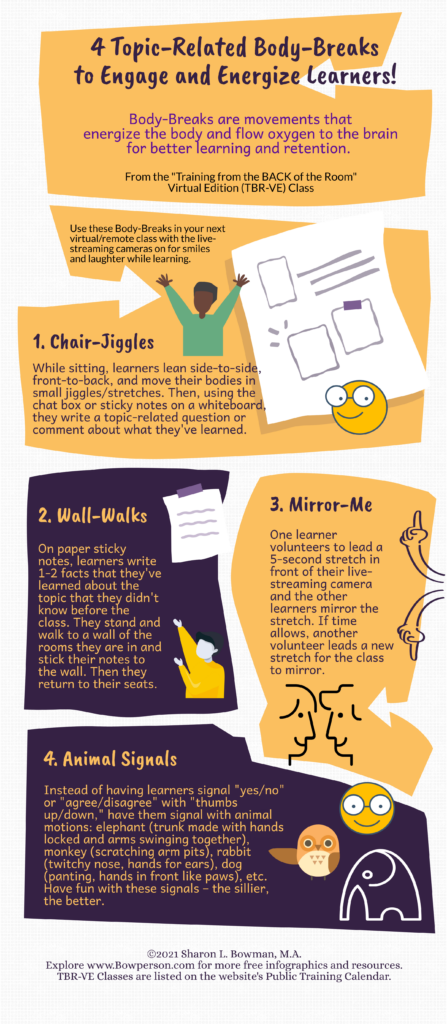Body-Breaks for Virtual Class Learners – Free Infographic
 Awhile back, I wrote a post about “Body-Breaks,” short quick physical movements that learners do to stretch their bodies and get more oxygen to their brains. Body-Breaks have become hugely important in virtual/remote learning environments.
Awhile back, I wrote a post about “Body-Breaks,” short quick physical movements that learners do to stretch their bodies and get more oxygen to their brains. Body-Breaks have become hugely important in virtual/remote learning environments.
 Sitting motionless for extended periods of time in front of a computer screen is damaging on many levels: physically, mentally, and emotionally. On the physical level, the body becomes lethargic as blood circulation decreases. On the mental level, the brain receives less oxygen and the ability to remain alert and to learn decreases. On an emotional level, the lack of stimulation leads to a feeling of boredom and the learner begins looking for distractions.
Sitting motionless for extended periods of time in front of a computer screen is damaging on many levels: physically, mentally, and emotionally. On the physical level, the body becomes lethargic as blood circulation decreases. On the mental level, the brain receives less oxygen and the ability to remain alert and to learn decreases. On an emotional level, the lack of stimulation leads to a feeling of boredom and the learner begins looking for distractions.
“Body-Breaks” are absolutely essential for successful learning in virtual/remote classes. These are not the so-called “official” breaks where the learners step away from their computers or leave the room for 10 minutes once an hour or two. Body Breaks are small, quick stretches and other movements that increase oxygen flow and that help learners stay focused and alert. In effect, Body-Breaks re-energize the body and mind. In addition to that, they are just plain fun!
 Research indicates that having at least one short physical Body-Break about every 5-10 minutes of virtual instruction is best for learning and retention (more than one is even better!).They can be as short as 2-3 seconds or as long as 15-30 seconds. They can be inserted at any time during a virtual class: before/during/after lecture segments, as part of the opening or closing, during breakout group discussions/activities, and anytime a burst of physical/mental energy is needed.
Research indicates that having at least one short physical Body-Break about every 5-10 minutes of virtual instruction is best for learning and retention (more than one is even better!).They can be as short as 2-3 seconds or as long as 15-30 seconds. They can be inserted at any time during a virtual class: before/during/after lecture segments, as part of the opening or closing, during breakout group discussions/activities, and anytime a burst of physical/mental energy is needed.
Right now, while reading this, roll your neck, stretch your arms above your head, lean back in your chair, feel the stretch in your back, and breathe deeply for a few seconds … There now, you probably feel a bit more awake and alert than you did a few seconds ago. That is a Body Break.
Or, just for fun, scrunch up your face while you massage your earlobes with your fingers for 4 seconds (count them: “One-thousand-and-one; one-thousand-and-two …”). Imagine how silly (and fun!) this would look in a Zoom class. That is another Body Break.
 Or think of a silly analog signal all learners can do during a live-streaming class that will tell you whether or not they agree/disagree with topic-related statements you verbally say. The traditional signal in a Zoom meeting is thumbs up (agree) and thumbs-down (disagree). What about flapping arms like a bird (agree) and using hands to swim like a fish (disagree)? Or bending forward/towards the camera (yes) and backward/away from the camera (no)? These are all Body Breaks, as well.
Or think of a silly analog signal all learners can do during a live-streaming class that will tell you whether or not they agree/disagree with topic-related statements you verbally say. The traditional signal in a Zoom meeting is thumbs up (agree) and thumbs-down (disagree). What about flapping arms like a bird (agree) and using hands to swim like a fish (disagree)? Or bending forward/towards the camera (yes) and backward/away from the camera (no)? These are all Body Breaks, as well.

Below is a link to a free PDF infographic you are welcome to download and share with colleagues who present virtual/remote classes. The topic-related Body-Breaks were created by a group of TBR Certified Trainers who are certified to present the TBR-VE™ Class (TBR – Virtual Edition). They have had fun experimenting with all sorts of silly, energizing ways to keep virtual learners engaged:
4 Topic-Related Body-Breaks to Energize and Engage Learners
*************
If you’re interested in attending a TBR-VE™ Class, click on the red button at the end of this blog for the 2022 public calendar of classes (be sure to check back as classes are added monthly).
For a description of the TBR-VE™ Class, click HERE.
Have questions about the TBR-VE™ Class? Click HERE.
For a comparison of the virtual and in-person TBR classes, click HERE.
Interested in becoming a “Training from the BACK of the Room” Certified Trainer? Click HERE.